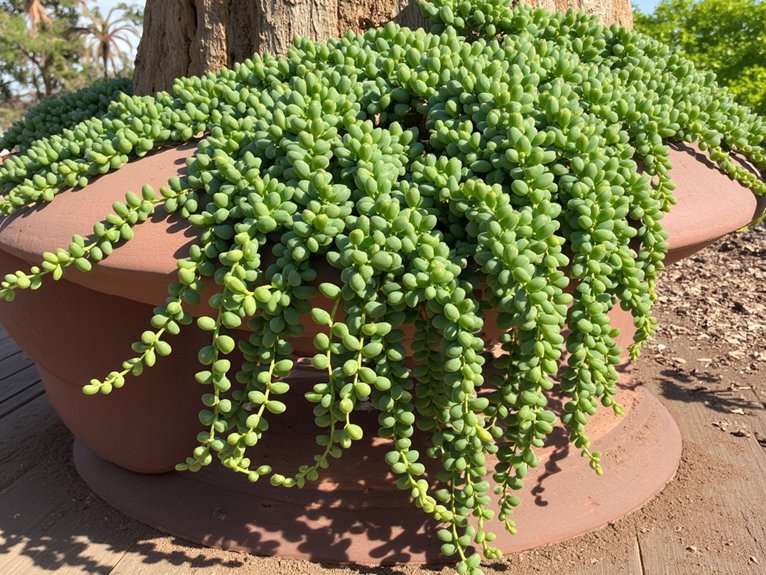While many believe jade plant repotting is purely about size requirements, the process actually hinges on multiple environmental and health indicators. You’ll need to monitor your plant for essential signs like rootbound growth, soil degradation, and irregular leaf patterns before initiating the repotting procedure. Understanding these signals, along with proper timing and technique, transforms this seemingly simple task into a precise horticultural art that determines your jade’s long-term health.
Contents
When Your Jade Plant Needs a New Home

While jade plants are known for their resilience, they’ll eventually outgrow their current containers and need repotting to maintain ideal health. You’ll know it’s time for repotting when you notice these key signs:
- Roots peeking through drainage holes or wrapping tightly around the soil base
- Yellowing or dropping leaves despite proper care
- Stunted growth or minimal new leaf development
- Soil that dries out much faster than usual
For best root health, repot younger jade plants every 2-3 years and mature plants every 4-5 years. Don’t rush to repot – these hardy succulents actually prefer being slightly rootbound.
Essential Tools and Materials for Success
Now that you’ve identified your jade plant needs repotting, gathering the right tools and materials will set you up for success.
You’ll need:
- Well-draining cactus/succulent soil mix
- Container with drainage holes (one size larger than current pot)
- Clean pruning shears
- Newspaper to protect your workspace
- Small trowel for soil handling
For soil selection, create a custom mix using:
- 2 parts cactus soil
- 1 part perlite
- 1 part coarse sand
“Container size is essential – too large can lead to root rot,” says botanist Dr. Sarah Chen. “Choose a pot just 1-2 inches wider than the current one.”
Step-by-Step Repotting Guide

Three key stages define the jade plant repotting process: preparation, execution, and aftercare.
To begin your repotting techniques, confirm your plant’s soil is completely dry. “A dry root system makes handling much easier and reduces stress on the plant,” notes botanist Dr. Sarah Chen.
Follow these essential steps:
- Gently remove the plant from its current pot
- Inspect and loosen the root system, trimming any damaged roots
- Place fresh succulent mix in the new container
- Position your jade plant at the same depth as before
- Fill remaining space with soil
Monitor root health by checking drainage and moisture levels for two weeks after repotting.
Post-Repotting Care and Recovery
Since your jade plant needs time to adjust after the stress of repotting, you’ll want to provide ideal care during the first few weeks of recovery.
Key Recovery Steps:
- Wait 7 days before watering to allow any damaged roots to heal
- Monitor soil moisture with your finger – only water when top 2 inches feel completely dry
- Keep the plant in bright, indirect light
- Maintain room temperatures between 65-75°F
“Watch for new growth within 4-6 weeks, which signals successful root establishment,” says botanist Dr. Sarah Chen. If leaves start dropping, check that soil isn’t staying too wet around the roots.
Troubleshooting Common Repotting Issues

While repotting your jade plant often goes smoothly, you may encounter a few common challenges that require prompt attention.
Common Issues to Watch For:
- Drooping leaves after repotting – Wait 5-7 days before watering to help roots recover
- Root rot from overwatering – Remove affected roots and replant in fresh, dry soil
- Yellowing leaves indicating nutrient deficiency – Apply balanced succulent fertilizer after 2 weeks
- Unstable plant – Add support stakes temporarily
- Leaf drop – Maintain consistent temperature and reduce direct sunlight for 1-2 weeks
“Quick intervention is key when troubleshooting post-repotting problems,” says botanist Dr. Sarah Chen.
